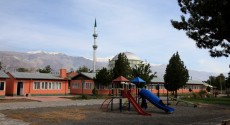Once more we are travelling west along the North Anatolian Fault, and our destination is the Mudurnu valley- a beautiful, peaceful landscape of mist-filled mountains and serene lakes and valleys created by the fault line. En route we stop off in Bolu. In the main street we are somewhat surprised…
read this entry »
27/10
The magic mushrooms of Mudurnu
25/10
Niksar, home of the humble walnut
What is becoming apparent to us as we travel further east along the North Anatolian Fault is the sheer scale of the area and number of people affected by it’s presence. We have driven for days across an expansive and much changing landscape, and whilst the urban connubations are few…
read this entry »
19/10
In the face of adversity
The weather is suitably broody as we head in a loop south from Erzincan, where we reach the Karliova triple junction – an area of unprecedented seismic activity where the Anatolian, Eurasian and Arabian tectonic plates meet. Many of the small rural villages in this area have experienced large earthquakes…
read this entry »
17/10
Rebuild and carry on
Following the North Anatolian fault westwards, in line with the series of earthquakes that are slowly moving in the same direction, we stopped at the city of Erzincan. Sitting firmly on the fault line, in 1939 Erzincan experienced seven tremors, the largest of which measured 8.2m on the Richter scale…
read this entry »
12/10
East is East
Hurtling towards Iran and we’ve been keeping a steady eye on Ahmadinejad’s antics. Unfortunately in the past few weeks his inappropriate comments at the UN and the ongoing nuclear debate mean British-Iranian relations are at a pretty all time low. The official FCO policy is that it’s fine to go…
read this entry »
09/10
Once upon a time…
We’ve made it down to the surreal, Dali-esque region of Cappadocia in central Turkey. Whilst this involves a significant detour off the North Anatolian fault, we decided to come here because it provides yet another fascinating example of how earthquakes can shape people’s lives and profoundly effect the local geography….
read this entry »
05/10
Education pays back
It is well known that education pays back significantly when it comes to mitigating earthquake risk. We’ve been told on numerous occasions that ‘earthquakes don’t kill, panic does’. It is not an exaggeration to say that many lives can be saved if people know the correct procedures to follow. The…
read this entry »
02/10
What the Greeks told us
Greece is the most seismically active country in Europe, experiencing thousands of earthquakes a year (the vast majority extremely mild) so it was always going to be interesting to talk to locals in Athens about how earthquakes affect their life, especially as the city experienced a serious earthquake in 1981….
read this entry »
27/09
It’s this fault’s fault
Our aim has always been to drive as close to fault lines as possible. Little did we really appreciate at the time that this would guarantee us such a spectacular journey. Fault lines often manifest themselves as beautiful mountains ranges or calm valleys, creating an enticing environment in which to…
read this entry »
25/09
We like Ologies… an archaeological detour
Earthquake geologists like Ioannis are constantly on the look out for evidence of old earthquakes. That way they can better understand the behaviour of fault lines over long periods of time. Mostly they find clues in the rocks themselves but sometimes the clues are more dramatic like here at Kechriai,…
read this entry »
23/09
Fame in the Peloponnese (our new album)
We’re in Kalamata to find out about life in the town, which was hit on 13th September 1986 by an earthquake of nearly 6.6 magnitude. Although 28 people lost their lives, in the long term the town made a hugely successful comeback from tragedy. Kalamata is the second biggest town…
read this entry »
21/09
Mega Trench
When we first began researching the trip we spoke to Dr Ioannis Papanikolaou, a Greek earthquake geologist, telling him we wanted to find out about any possible benefits of fault lines. His answer was immediate… when you come to Greece you’ll see. And driving from Nafpaktos to Athens we did….
read this entry »
19/09
The trouble with earthquakes…
A headline we read the other day summed it up.. “Scientists can’t predict earthquakes but toads might be able to” It was about a study published in the Journal of Zoology which claimed that toads had detected the L’Aquila earthquake days before it struck. Zoologist Dr Rachel Grant studying toads…
read this entry »
12/09
We eat, drink and get on with it
Greece is one of the most seismically active countries in the world. It is riddled with fault lines and frequently experiences earthquakes. We visited the town of Nafpaktos, near the Corinth – Patras rift which experienced a 5.1m earthquake in January this year. We talked to some of the local…
read this entry »
08/09
Step into the red zone of L’Aquila
Washing blows in the wind long since dried, a child’s toy lies abandoned in a pile of rubble, an entire bathroom hangs at an impossible angle from a decimated apartment block. On every street corner are the haunting signs of a city abandoned in minutes, as people fled their houses…
read this entry »
05/09
For all the geologists out there
The seismometer we’re carrying around with us has be to be single heaviest thing we own, especially given how small it is. It also happens to resemble a small bomb, so we won’t be taking it into Iran. When we first set off, we naively imagined we’d be doing a…
read this entry »


















